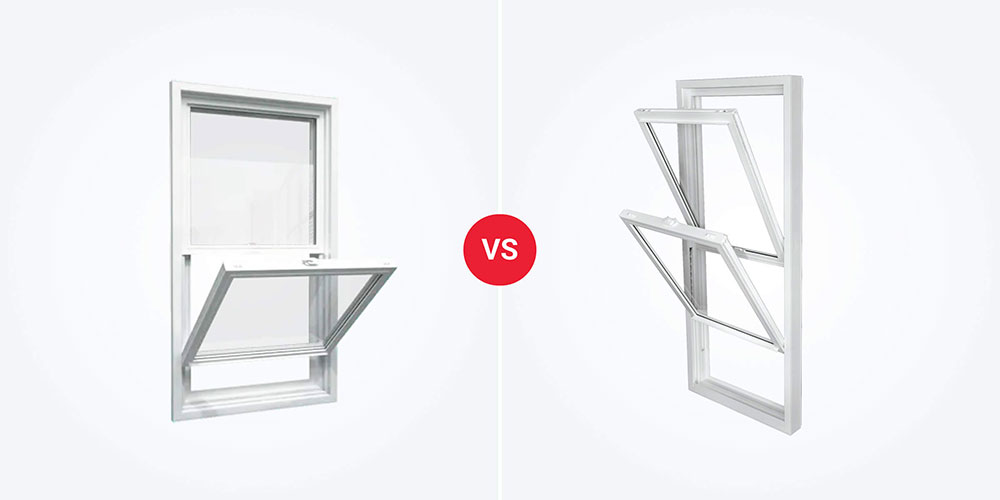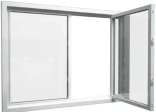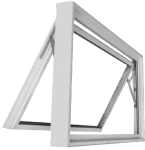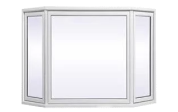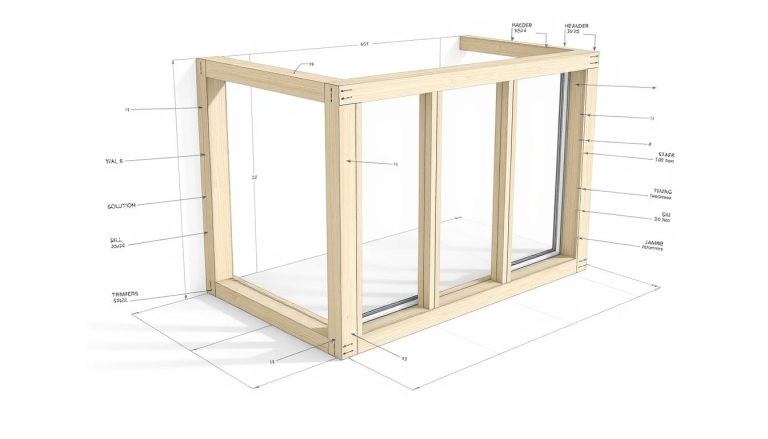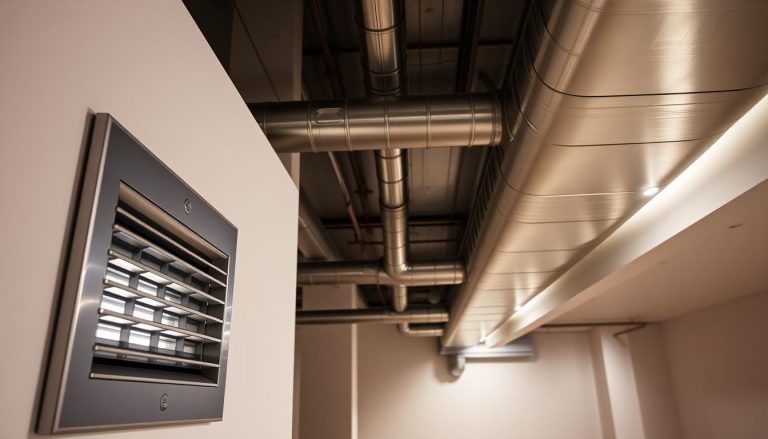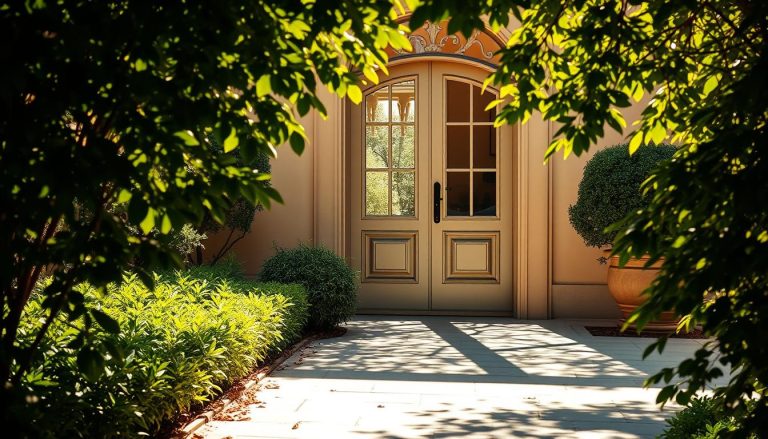Did you know that upgrading to energy-efficient windows can reduce your home’s utility bills by up to 15% annually? Choosing the right window style, however, is critical for achieving these savings. Single hung and double hung windows are two of the most popular styles among Canadian homeowners. While they may look similar, their differences can have a significant impact on your home’s ventilation, maintenance, and overall aesthetics.
This guide will compare single hung vs double hung windows to help you make an informed decision. Let’s dive in!
Window Replacement Near Me
Single-hung Windows VS Double Hung Windows
A Timeless Choice
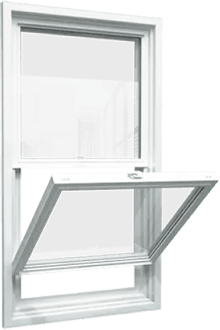
A single hung window is a type of window that has a fixed upper sash and a movable lower sash. The lower sash can be opened by sliding it up and down, allowing for ventilation and airflow. Single hung windows are a classic choice and have been used in home design for centuries. They are known for their simplicity, affordability, and energy efficiency.
Versatile and Functional
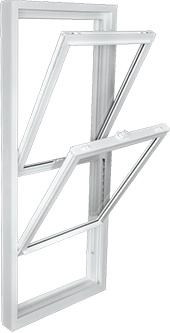
A double hung window is a type of window that has two movable sashes, both of which can be opened by sliding them up and down. This allows for greater control over ventilation and airflow, making double hung windows ideal for hot climates or homes where airflow is essential. Double hung windows are also known for their ease of maintenance and cleaning, as both sashes can be tilted inward for easy access.
Pros of Single Hung Windows
Pros of Double Hung Windows
Cons of Single Hung Windows
Cons of Double Hung Windows
Find related services
Side-by-Side Comparison
Similar Features
- Both styles offer timeless aesthetics suitable for various architectural designs.
- Available in a range of materials such as vinyl, and aluminium.
- Both contribute to improved energy efficiency when combined with quality insulation.
Key differences
| Feature | Single Hung Windows | Double Hung Windows |
| Ventilation | Limited to bottom sash | Both sashes can open |
| Maintenance | Lower due to fewer moving parts | Higher due to additional mechanisms |
| Cleaning Ease | Challenging for upper sash | Easy with tilt-in sashes |
| Cost | $270-$850 | $500-$900 |
| Energy Efficiency | High due to fixed upper sash | Slightly lower due to more gaps |
| Security | Fewer security options | Enhanced security with advanced locks |
| Customisation | Fewer options | Wide range of grid and hardware choices |
Ventilation and Airflow
- Double hung windows offer more ventilation options, as both the top and bottom sashes can move.
- Single hung windows only allow for ventilation through the bottom sash.
- Double hung windows are ideal for hot climates or homes where airflow is essential.
Energy Efficiency
Single hung windows are considered more energy efficient due to fewer moving parts. Choosing the right windows, including replacement windows, can significantly impact your home’s comfort, style, and efficiency. Double hung windows can have higher air leakage rates, leading to higher electricity bills. High-quality, well-sealed double hung windows are available, but may be more expensive.
Security
- Double hung windows can be less secure if not shut properly, as gravity can pull down the upper sash and cause it not to lock completely.
- Single hung windows can be dangerous for small children, as they can open the top sash while leaving the bottom closed.
- Proper safety measures can ensure the security of both double hung and single hung windows.
Energy Efficiency
“Double hung windows are an excellent choice for homes that need maximum ventilation and easy maintenance, particularly for upper floors.” – Eugene Siukayev, Project Manager.
Find related products
Recommendations Based on Your Needs
Choose Single Hung Windows If:
You are renovating on a budget.
Your priority is durability and minimal maintenance.
You’re focusing on ground-level or dormer windows.
Choose Double Hung Windows If:
You want versatile ventilation options.
Easy cleaning is important, especially on upper floors.
You’re investing in long-term home value.
Installation Considerations
When it comes to installation, single hung windows offer simplicity and cost efficiency.
Single Hung Windows
Fewer Moving Parts: Single hung windows are easier to install because they have only one operable sash, reducing the complexity of the process.
Lower Installation Costs: Installation typically costs between $75 and $100 per window, making them a budget-friendly choice.
DIY-Friendly: For homeowners comfortable with basic tools, single hung windows can be a manageable DIY project.
Double Hung Windows
Complex Mechanisms: Double hung windows have two operable sashes, requiring precise alignment during installation.
Higher Installation Costs: Professional installation is often necessary, costing between $150 and $250 per window.
Professional Expertise: Hiring professionals ensures the tilt-in mechanisms and ventilation features are properly installed, enhancing functionality.
Size Considerations
Window size plays a significant role in determining the best style for your space.
Single Hung Windows
Compact Options: Single hung windows are available in sizes as small as two feet wide by three feet tall, making them ideal for bathrooms and small spaces.
Energy Efficiency: The smaller fixed upper sash in single hung windows helps maintain insulation and minimise air leakage.
Double Hung Windows
Versatile Sizes: Double hung windows range from compact to large, with options as big as six feet wide by 12 feet tall.
Grand Designs: Their large sizes make them perfect for rooms requiring expansive views or enhanced natural light.
Popular Home Styles for Single Hung Windows
Single hung windows offer a timeless look that complements various architectural styles.
- Historic Aesthetic: Perfect for homes with traditional, colonial, or Victorian designs, single hung windows provide a classic appeal.
- Ground-Level Rooms: Commonly used in areas where additional ventilation isn’t crucial, such as dining rooms and basements.
- Low Maintenance: With fewer moving parts, single hung windows are ideal for homeowners seeking low-maintenance options.
Popular Home Styles for Double Hung Windows
Double hung windows are versatile enough to suit both modern and traditional designs. Various window styles, including single-hung and double-hung windows, can enhance both the visual and functional aspects of a home.
- Colonial and Victorian Styles: These windows maintain a cohesive aesthetic with intricate architectural details.
- Modern Homes: Double hung windows with sleek frames and tilt-in sashes blend well with contemporary designs.
- Two-Story Homes: Their ventilation control makes them a favourite for upper floors and larger spaces.
Where to Use Double Hung Windows
Double hung windows excel in areas where ventilation and easy maintenance are priorities.
- Upper Floors: Tilt-in sashes simplify exterior cleaning, making these windows ideal for second-story rooms.
- High-Traffic Rooms: Kitchens and living rooms benefit from the superior airflow and fresh air provided by double hung windows.
Enhanced Ventilation: Their ability to open both sashes allows for natural temperature control, with cool air entering through the bottom and warm air exiting through the top.
Where to Use Single Hung Windows
Single hung windows work well in spaces where simplicity and cost efficiency are key considerations.
- Ground-Level Rooms: Perfect for areas where cleaning and ventilation are less of a concern.
- Budget-Friendly Spaces: Single hung windows are a cost-effective choice for rental properties or secondary rooms.
- Utility Rooms: Their compact design and affordability make them ideal for laundry rooms, storage areas, and garages.
Final Thoughts
Choosing between single hung and double hung windows depends on your specific needs and budget. While single hung windows offer affordability and simplicity, double hung windows provide superior functionality and ease of maintenance.
At Total Home Windows and Doors, we’re here to help Canadian homeowners find the right windows for their homes. Explore our range of single-hung windows or contact us for expert guidance.
"Every home is unique, and the right windows should enhance its comfort, style, and efficiency." – Vitaly Shapiro, Vice President of Sales.
Frequently Asked Questions
Which is better for energy savings?
Single hung windows are typically more energy-efficient because their fixed upper sash reduces air leakage. However, both window types can contribute to energy savings when paired with high-quality materials like fvinyl and UV protection coatings.
Are double hung windows worth the cost difference?
Double hung windows are worth the additional cost if you value features like enhanced ventilation, ease of cleaning (thanks to tilt-in sashes), and versatility for upper floors or areas needing extra airflow.
Can single hung windows provide adequate ventilation?
Single hung windows provide sufficient ventilation for smaller or lower floors, especially where only the bottom sash needs to open. However, double hung windows excel in offering extra ventilation by enabling airflow through both sashes.
Is replacing windows a daunting task?
Replacing windows doesn’t have to be overwhelming. At Total Home Windows and Doors, our team simplifies the process, offering guidance to find the right style and ensuring professional installation for both single and double hung windows.
Which is better for lower floors?
Single hung windows are ideal for lower floors due to their simplicity, cost-efficiency, and minimal need for exterior cleaning. They also serve as a natural insulator, maintaining consistent temperatures.
Do double hung windows offer additional features?
Yes, double hung windows often come with added features like tilt-in sashes for cleaning ease, advanced locking mechanisms for security, and larger size options for better views and ventilation.
Why do double hung windows tend to suit upper floors better?
Their tilt-in design simplifies exterior cleaning, making them convenient for second-story rooms. They also provide superior ventilation control, allowing warm air to escape through the top sash while cool air enters through the bottom.
Can single and double hung windows provide a timeless look?
Absolutely. Both styles complement various architectural designs, from traditional colonial homes to modern aesthetics, offering a long history of versatile applications in home design.

